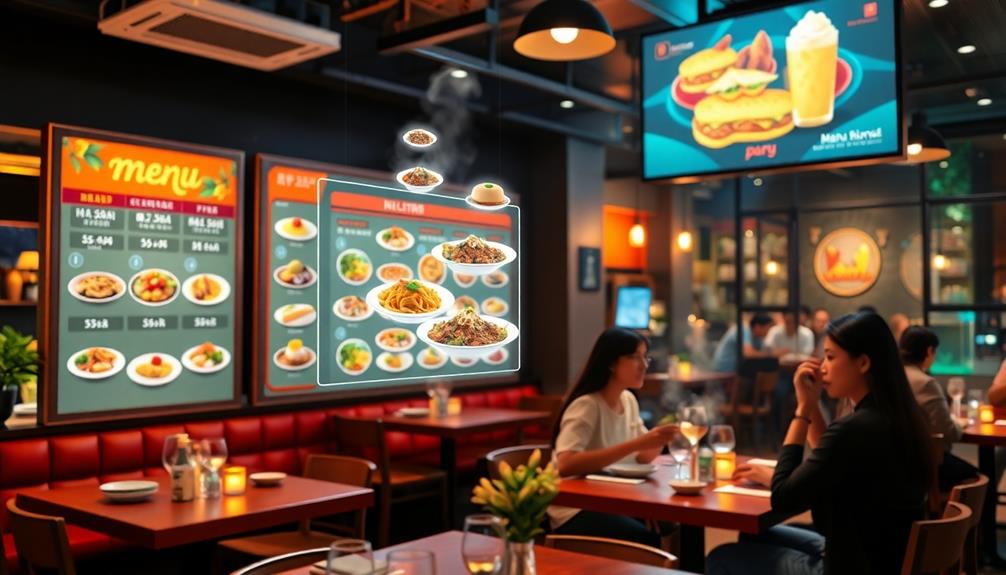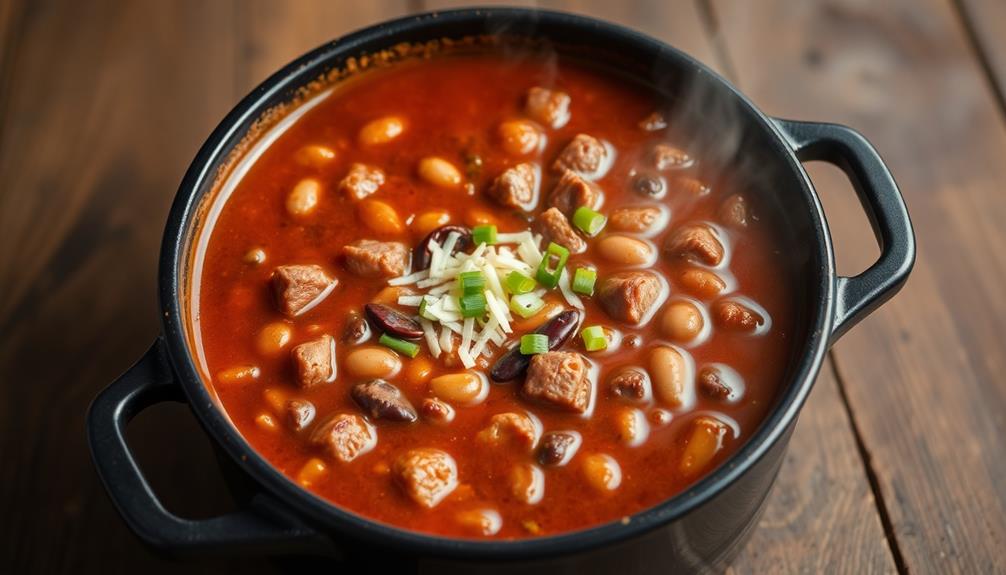Augmented reality is revolutionizing restaurant menus by enhancing how you interact with food. When you scan an AR-enabled QR code, you reveal immersive visuals and 3D representations of dishes that elevate your dining experience. You'll explore ingredient stories and learn about meal prep methods, making informed choices. Personalized recommendations based on your tastes take engagement to another level. This technology fosters a deeper appreciation for your meal while creating memorable dining experiences. If you're curious about how AR shapes the future of restaurants and enhances customer satisfaction, there's much more to discover about this exciting trend.
Key Takeaways
- Augmented Reality (AR) enhances restaurant menus by providing immersive 3D visualizations of dishes, improving customer engagement and anticipation.
- AR allows customers to explore ingredient information and preparation methods, fostering informed decision-making about meal selections.
- Personalized dish recommendations and pairing suggestions through AR increase customer satisfaction and loyalty to the restaurant.
- Interactive storytelling elements, such as chef profiles and ingredient sourcing narratives, create memorable dining experiences and connections to the restaurant ethos.
- Future AR developments streamline ordering processes, enhance customization options, and improve overall dining efficiency and enjoyment.
Definition of Augmented Reality in Menus

Augmented Reality (AR) in menus transforms your dining experience by overlaying digital content onto the physical world. This innovative technology allows you to scan AR-enabled QR codes, which triggers an immersive interaction with menu items.
You'll see 3D representations of dishes superimposed onto your table, making it easier to visualize what you're about to order. For instance, imagine seeing a Kue Putu in vibrant detail, enhancing your anticipation for this traditional dessert.
With AR, your dining experience becomes interactive. You can explore detailed visuals, ingredient information, and preparation methods for each dish. This level of engagement not only elevates your understanding of the menu but also supports informed decision-making.
You can assess portion sizes and presentation styles before committing to a selection, ensuring that you choose exactly what you want.
AR menus create a unique atmosphere that encourages exploration and appreciation of culinary offerings. Instead of simply reading a list of items, you're diving into a rich, interactive experience that enhances your connection to the food.
This immersive approach transforms the way you perceive dining, making it both exciting and informative. So next time you sit down to eat, expect a dining experience that's not just about the food but also about how you discover it.
Immersive Dining Experiences
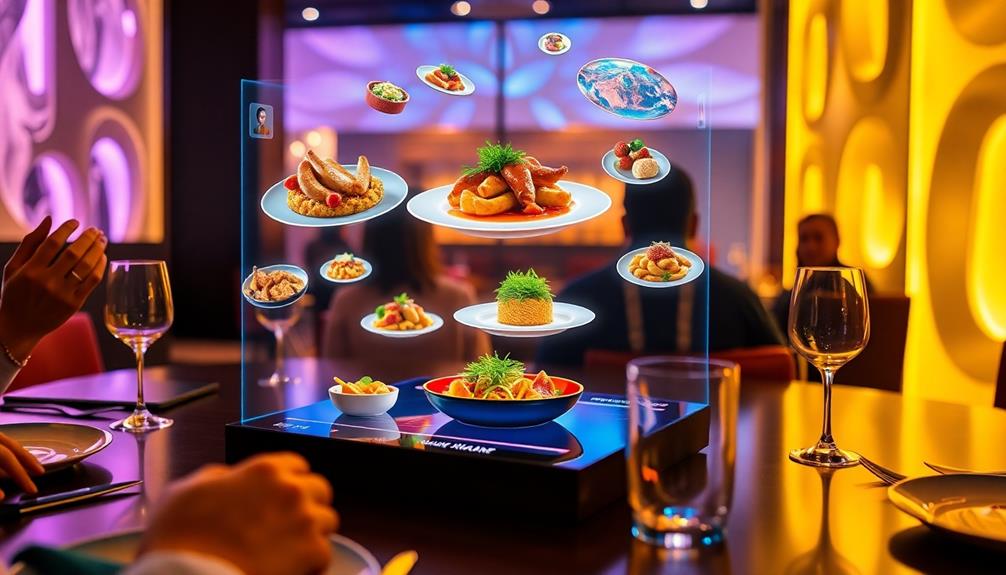
Imagine scanning your menu to see vibrant 3D models of dishes that not only showcase their size but also their stunning presentation.
With augmented reality, you can explore ingredients and discover how each meal is crafted, making your dining experience much more interactive.
For instance, you might get a closer look at the intricate preparation of Red-Braised Pork Belly, known for its rich flavor and tender texture, enhancing your appreciation of this beloved dish.
This engaging approach transforms your meal into a visual feast, sparking curiosity and enhancing your appreciation of every bite.
Enhanced Visual Exploration
Many diners find that augmented reality (AR) transforms their menu experience into something extraordinary. With AR menus, you can scan your meal options and view detailed 3D models of each dish, allowing for enhanced visual exploration.
For instance, seeing a 3D representation of a Mushroom Masala could give you a better sense of its rich blend of spices and earthy mushroom flavor, fostering a deeper appreciation of what you're about to savor. This technology lets you visualize ingredients and preparation methods through mesmerizing animations, fostering a deeper understanding and appreciation of what you're about to savor.
The interactive experience elevates the dining atmosphere, making it more unique and engaging. You'll get to explore presentation styles and portion sizes in a lifelike manner, turning the act of choosing a meal into an immersive experience.
As you navigate through the menu, you might discover dishes you wouldn't have considered otherwise, all thanks to the enhanced visual appeal AR provides.
Interactive Ingredient Discovery
Releasing a new level of engagement, interactive ingredient discovery through AR transforms how you connect with your meal. With AR technology, you can dive deeper into your dining experience, making it not just about eating but exploring.
Imagine sitting down to a menu where each item reveals its secrets at your fingertips. You might even uncover the cultural fusion behind dishes like Brazilian cuisine that blend indigenous, African, and Portuguese flavors.
- Detailed 3D Models: Scan dishes to visualize portion sizes and presentation.
- Ingredient Insights: Discover the sourcing and history behind each flavor.
- Visual Modifications: Experiment with meal changes through interactive animations.
- Enhanced Education: Learn about preparation methods while dining.
This immersive approach doesn't just enhance the dining experience; it fosters a personalized experience tailored to your preferences.
By engaging with your food in such a unique way, you cultivate a deeper appreciation for every bite. AR transforms the traditional menu into an exploratory adventure, encouraging you to try new dishes and elevating your satisfaction.
With interactive ingredient discovery, your meal becomes a journey, making each dining occasion memorable and enjoyable.
Engaging Meal Presentations
Building on the interactive ingredient discovery, engaging meal presentations further elevate your dining experience by transforming how dishes are showcased. With augmented reality (AR), you can scan menu items and instantly view detailed 3D models of your potential meals. This visualization helps you appreciate the dish before ordering, enhancing your overall customer experience.
For instance, imagine a themed dining event where you can explore spooky food ideas with AR elements that add an entertaining twist to traditional meals.
Imagine immersing yourself in a dining experience where engaging animations reveal ingredient sourcing and preparation methods. This not only enhances your understanding of the meal but also fosters a deeper appreciation for what's on your plate.
AR enhances the sensory experience by providing lifelike depictions of dishes, allowing you to make informed decisions about portion sizes and ingredients.
Moreover, the interactive elements of AR dining experiences create an engaging atmosphere that entices you to explore new menu items. Studies show that such presentations can increase customer satisfaction and even boost sales in the restaurant industry.
Personalized Recommendations and Visualizations
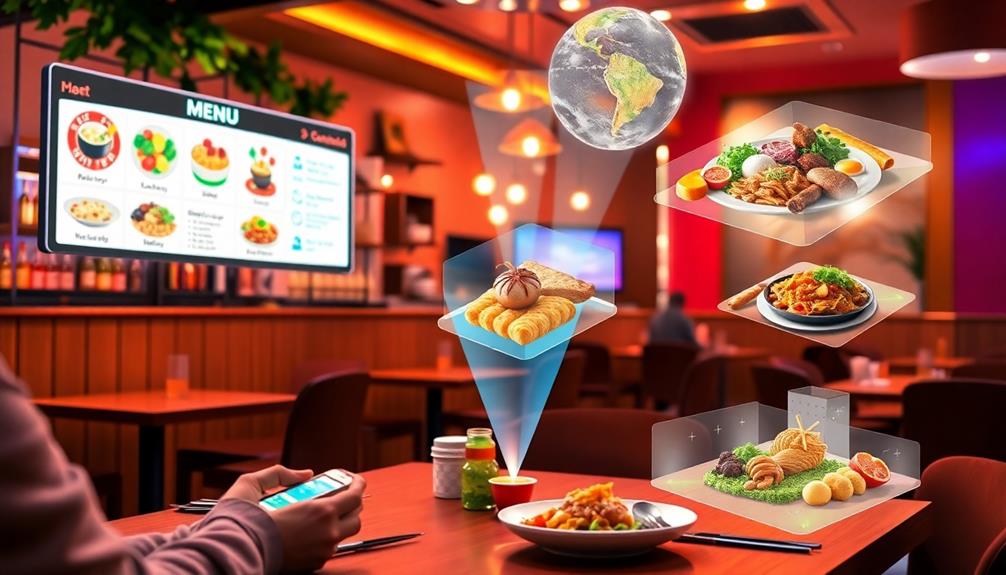
Augmented Reality (AR) menus are transforming how you choose your meals by offering personalized recommendations tailored to your tastes and dietary needs. With the help of AR technology, you can enjoy a dining experience that's not only interactive but also customized for you.
Imagine sitting down at a restaurant and experiencing:
- Tailored dish suggestions based on your preferences and dietary restrictions, perhaps even introducing you to unique options like Dorayaki (Red Bean Pancake) that you mightn't have considered.
- Complementary pairings for beverages or sides, enhancing the overall meal satisfaction.
- Lifelike visualizations of your meal, helping you understand portion sizes and presentation before you order.
- Real-time modifications, allowing you to see how ingredient swaps or portion adjustments will impact your dish.
These personalized recommendations and stunning visualizations elevate your dining experience by making it more engaging.
With AR menus, you're not just choosing food; you're exploring a world of flavors and presentations designed just for you. This innovation not only enhances your satisfaction but also fosters loyalty, as you feel a deeper connection with the restaurant.
Embrace this technology, and discover how it redefines your culinary journey.
Interactive Storytelling and Engagement
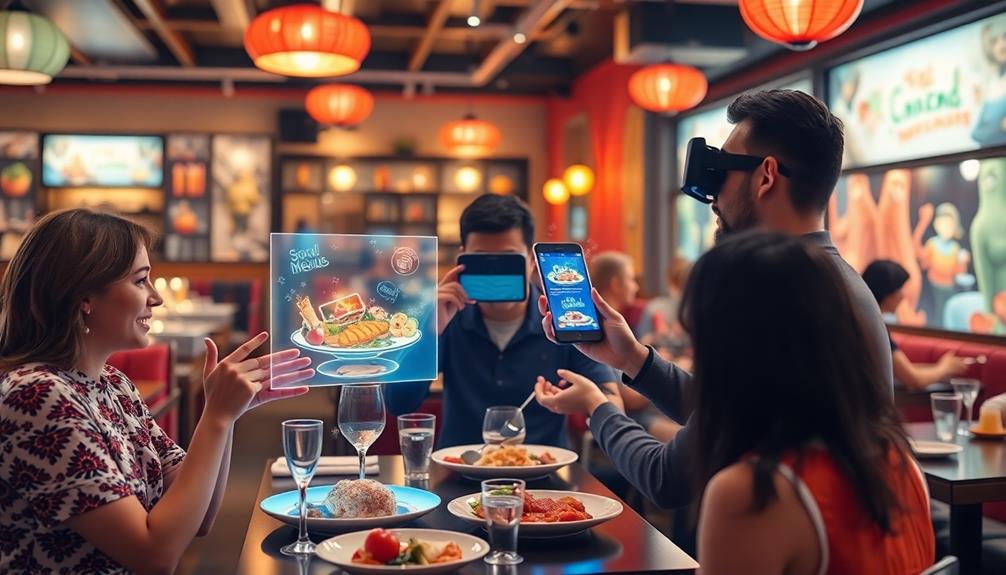
When you explore AR menus, you'll uncover the fascinating stories behind ingredient sourcing, chef profiles, and culinary processes.
For instance, you might learn about the seasonal ingredients used in dishes like Nettle and Potato Soup, which highlights the nutritional benefits of fresh nettles.
This interactive storytelling not only engages you but also brings the food to life, making your dining experience much richer.
Ingredient Sourcing Narratives
Many diners crave a deeper connection to their meals, and AR menus deliver just that by narrating ingredient sourcing stories. With AR technology, you can explore the journey of your food, enhancing your dining experiences and appreciation for what's on your plate.
Imagine sitting down to a dish and uncovering:
- The local farm where your vegetables are grown, showcasing sustainable practices.
- An animated visual of the cooking process, bringing the meal's creation to life.
- Insights into the ethical sourcing of seafood and meats, ensuring quality and care.
- The restaurant's commitment to supporting community farmers, strengthening local ties.
- The origins of traditional dishes like Tella (Traditional Beer), which reflect the local culture and brewing methods.
These ingredient sourcing narratives not only enrich your restaurant experience but also foster a sense of loyalty. When you understand the story behind your meal, it transforms into something more than just food—it's a connection to the people and practices that make it possible.
Chef Profiles Showcase
A chef's passion can transform a simple meal into an unforgettable experience, and AR menus make it easier than ever to connect with the culinary minds behind your food. Through augmented reality, you can explore interactive chef profiles that reveal the journey, expertise, and philosophy behind each dish. This immersive experience enhances your customer connection to the meals you enjoy, whether it's a comforting stracciatella soup or a classic pasta dish.
Imagine scanning a QR code and watching a video of the chef in action, deftly preparing your dish. You'll learn about the sourcing of ingredients and the inspirations that drive their culinary creativity. This storytelling approach fosters deeper emotional engagement, allowing you to appreciate the artistry involved in your meal.
As you navigate through these chef profiles, you'll uncover unique insights into their cooking techniques, elevating your dining experience. This innovative use of augmented reality not only makes your meal more meaningful but also helps restaurants stand out in a competitive market. By using this technology, diners can better understand the artistry and skill that goes into each dish, creating a more immersive and educational dining experience. Additionally, the incorporation of virtual reality in culinary education allows aspiring chefs to learn from the best in a more interactive and engaging way. This combination of innovative technology and traditional culinary methods is shaping the future of the dining industry.
Culinary Process Insights
Discovering the culinary process behind your meal can transform your dining experience into an engaging journey. With augmented reality (AR) menus, you can dive deep into the story of your food, enhancing your appreciation for each dish. For instance, when exploring a dish like Chilaquiles, you can learn about the traditional use of leftover tortillas in Mexican cuisine, bringing a cultural context to your meal.
Here's how AR elevates customer engagement through immersive and interactive storytelling:
- Ingredient Sourcing: Learn about where your ingredients come from and their quality.
- Chef Narratives: Discover the backgrounds and culinary philosophies of the chefs who created your meal.
- Preparation Methods: Visualize the cooking techniques through interactive animations that bring your dish to life.
- Historical Context: Gain insights into the history of the dishes, enriching your overall experience.
Each element of AR not only makes the experience more enjoyable but also fosters a deeper connection to the restaurant's ethos.
By exploring the culinary process from farm to table, you'll find yourself more engaged and invested in your meal. This innovative approach to dining not only entertains but educates, making every visit memorable.
Embrace the future of dining, where your meal is more than just food—it's an immersive story waiting to be discovered.
Future of AR in Dining

Increasingly, restaurants are exploring the future of augmented reality (AR) to elevate the dining experience. With advancements in AR technology, you might soon interact with your menu through wearable devices, making ordering more engaging and efficient.
Imagine being able to see your meal's real-time presentation before it even arrives at your table. Restaurant owners are recognizing that integrating AR can streamline the dining process, allowing for quick and easy ordering directly from AR menus.
This innovation not only saves time but also enhances your experience by offering tailored dish suggestions that cater to your preferences and dietary needs. As AR technology continues to evolve, its potential to create personalized dining experiences becomes clearer.
You'll likely find that restaurants using AR will stand out, making your visits truly memorable occasions. The competitive edge gained through AR will drive restaurant owners to adopt these technologies, ensuring that customer satisfaction and retention remain high.
The future of dining is bright with AR, promising to transform how you enjoy meals while making every outing an unforgettable event.
Customer Experience and AR Integration

Imagine walking into a restaurant and instantly being enchanted by an interactive menu that brings dishes to life in stunning 3D visuals. This AR integration elevates your customer experience, transforming ordering into an engaging adventure. You can explore each dish like never before, ensuring you make informed choices.
- Visualizations of ingredients and portions allow you to see exactly what you're getting.
- Customization options cater to your dietary restrictions, helping you modify dishes with ease.
- Enhanced engagement with mesmerizing visuals encourages you to try new items and flavors.
- Memorable dining experiences are created, leaving a lasting impression long after the meal.
With AR menus, you're not just choosing a meal; you're participating in a dynamic experience that enhances your satisfaction.
Research shows that this technology positively affects your perception of dining by appealing to your senses and intellect.
Plus, operational efficiency improves, minimizing order errors and allowing real-time updates.
This is the future of dining—where your preferences and needs come first, turning every meal into a delightful journey.
Frequently Asked Questions
What Technology Is Required for AR Menus in Restaurants?
To implement AR menus in restaurants, you'll need smartphones or tablets with AR capabilities, specialized software for menu creation, and a reliable internet connection to seamlessly deliver immersive experiences to your customers.
How Much Do AR Menus Typically Cost to Implement?
Implementing AR menus can cost anywhere from a few thousand to tens of thousands of dollars, depending on features and customization. While it seems pricey, the engaging experience can markedly boost customer satisfaction and sales.
ARe AR Menus Accessible for Visually Impaired Customers?
Yes, AR menus can be accessible for visually impaired customers if designed thoughtfully. You can incorporate features like voice commands or haptic feedback, ensuring everyone can enjoy a seamless dining experience while exploring the menu.
Can AR Menus Be Used for Takeout or Delivery Orders?
AR menus can enhance your takeout or delivery experience. They'll showcase scrumptious selections, simplify your choices, and spark your appetite. You'll enjoy an interactive journey, making meal decisions more delightful and dynamic than ever!
How Do Customers React to AR Menus Compared to Traditional Menus?
You'll find customers often react positively to AR menus, enjoying the interactive experience. They appreciate seeing dishes in 3D, which enhances their decision-making. In contrast, traditional menus can feel static and less engaging.
Conclusion
As you step into the future of dining, imagine a world where your meal comes alive, much like a scene from *Alice in Wonderland*. Augmented reality transforms ordinary menus into enchanting experiences, letting you explore flavors and stories in vibrant detail. You're not just ordering; you're starting a culinary adventure, where every dish whispers its tale. Embracing AR in restaurants doesn't just enhance your meal; it creates memories that linger long after the last bite.
